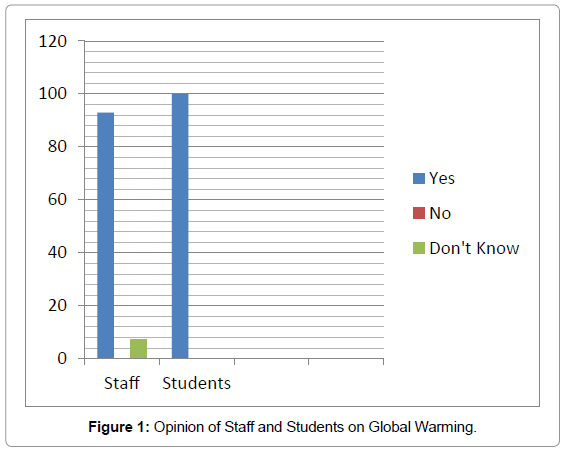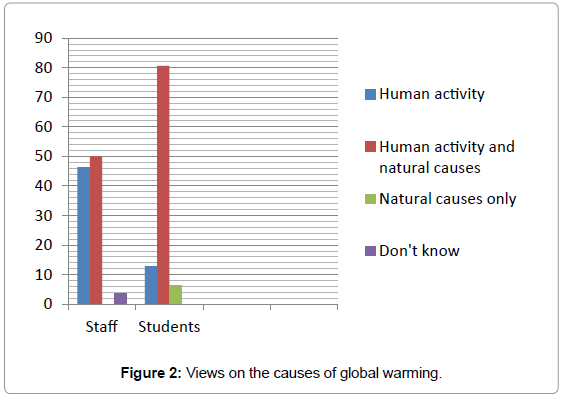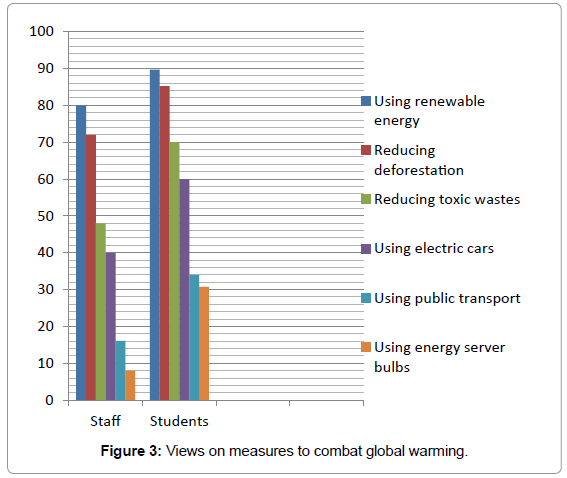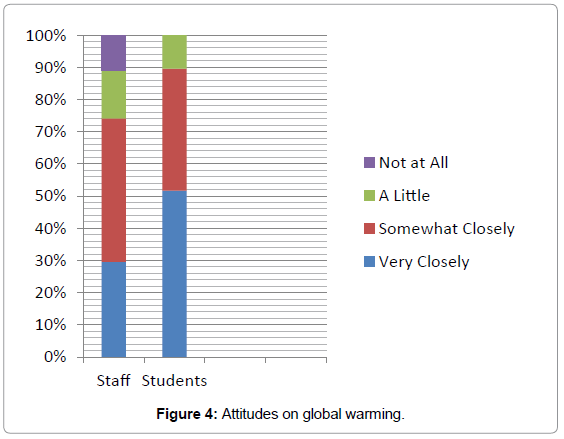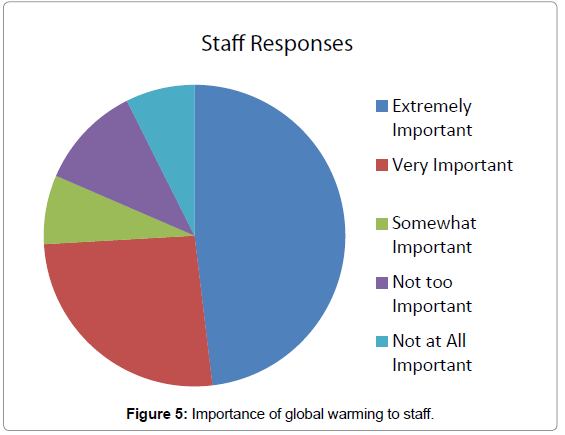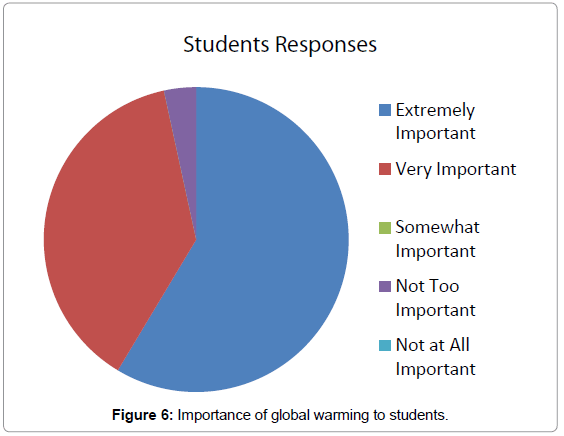Global Warming: Facts and Misconceptions by Staff and Students at Great Zimbabwe University
Received: 26-Jan-2014 / Accepted Date: 26-Jun-2014 / Published Date: 05-Jul-2014 DOI: 10.4172/2090-5009.1000107
Abstract
The study explores the accuracy, misconceptions and opinions about global warming which is held by Great Zimbabwe University community on the causes, impacts and measures to alleviate global warming. A case study approach was carried out with questionnaires distributed to different groups within the University community. Stratified sampling was used to cater for the various groups. The sample population from each sub group was selected using random sampling in order to ensure a representative sample. The research showed that, all the students were aware of global warming unlike the staff. The students exhibited more knowledge on the causes, consequences and measures to curtail global warming. The staff required more information on global warming. Students followed more closely and cheaper sources of information on global warming than the staff. The study recommended workshops, seminars and paper presentations in order to increase the University awareness on global warming. The University curriculum should entail modules on global warming and climate variability.
Keywords: Global warming; Staff; Students; University community; Climate change and variability; Impacts; Facts; Misconceptions
17542Introduction
Global warming is a current and pertinent issue in that it impacts greatly upon the socio-economic lives of people, their economies and the environment. Despite the dangers it poses upon peoples’ lives, there seem to be a misunderstanding, misconception and lack of adequate information on the causes, impacts and what can be done to ameliorate the situation of global warming. It is the purpose of this paper to explore the extent to which Great Zimbabwe University students and staff understand the facts about global warming. These are the people who are supposed to take a leading role on impacting accurate knowledge to the local community and nation. The results of the research would provide recommendations that could be adopted by Educational Institutions to address the anomaly. Global warming is the situation where there is a general rise in temperature as a result of the effect of greenhouse gases in the atmosphere. Greenhouse gases include carbon dioxide, chlorine and methane generally known as chlorofluorocarbons.
Climatic Change And Variability
Climate has always been changing since immemorial. Episodes of warming and cooling have been experienced in the past. During the Pleistocene (20000 to 12000 years before present) the world experienced low temperatures resulting in ice sheets covering the land surface. This prompted low evaporation and low rainfall. The Holocene period (12000 to 4000 before present) was characterised by high temperatures in much of Africa causing ice sheets to melt and high rainfall experienced Global temperatures are said to have increased since 1900 with episodes of falling temperatures between 1940 and 1970 and a rise in temperature than expected during 1920 to 1940 [1].
Causes of global warming
The atmosphere is warmed through a process called greenhouse effect in which the atmosphere is transparent to passing incoming short wave radiation where as long wave radiation is opaque to outgoing long wave radiation. Atmospheric gases such as water vapour, carbon dioxide, chlorine and methane act as atmospheric blanket that traps outgoing radiation. Carbon dioxide is a good heat absorber. Warming of the atmosphere is therefore fuelled by burning of fossil fuels in industries. The destruction of forests through fires for agriculture and settlement has added carbon dioxide into the atmosphere that eventually absorbs heat to increase atmospheric temperature. Rice cultivation in wetlands has also contributed to the production of methane. The effect is to increase global temperatures a process called global warming. Warming of the atmosphere can also result from natural factors. The earth’s orbit can change during a cycle that ranges from 90 00 to 100 000 years. The shape can either be circular to elliptical such that when it is elliptical more radiation is received during perihelion [about January 3] than aphelion [about 4 July] in the Northern Hemisphere [2]. Changes in the tilt of the earth within a cycle of about 41 000 years can vary from 22.1 to 24.5 degrees resulting in warmer temperatures when the earth is closer to the sun and cold when it is furthest from the sun. Solar output also varies in a manner that greater output produces warm temperatures and less solar output causes low temperatures over the earth’s surface. Sun spots can contribute to either warming or cooling of the earth’s surface. These are magnetic dark blemishes on the sun that stretches into the atmosphere that take place in cycles of 11 or 22 years. Plenty sunspot activity has been attributed to warmer temperatures and droughts [2].
Impact Of Global Warming
There are spatial variations on the socio-economic and environmental effects of global warming depending on the level of technological advancement of each region to tackle the challenges of global warming. Some regions become drier and hotter where as some become wetter and cooler. Global warming can result in extreme temperatures of heat and cold. More heat waves, heavy rains, increased cyclones and drought are likely to be experienced due to global warming [3]. These direct impacts would indirectly affect a range aspects on the environment. The increased temperatures would increase the spread of diseases in crops and animals. Vegetation can dry up due to high temperatures and low precipitation received in some regions. At the same time increased temperature can tolerate some plants and animals to survive in those regions. In drought affected areas there would be a decline in crop yields. Coastal flooding and erosion can increase due to increased rainfall and cyclones in coastal areas and ice melting regions. Coastal flooding can destroy infrastructure and aquatic ecosystem [3]. The sea level also rises due to glacial melting and thermal expansion of water. This may cause shore line shifting. There is also dwindling of arctic ice as well as decline in permafrost in the Northern hemisphere in terms of area coverage and thickness attributed to increased temperatures that causes melting of ice sheets [2].
Purpose of the study
The impact of global warming is changing the socio-economic, natural and political environment over the Globe. International agreements have been signed in an effort to ameliorate or prevent the further deterioration of the environment due to global warming. Different Nations have put in place programmes to alleviate the situation. It is the purpose of this study to assess the extent in which University Staff and Students understand this pertinent subject. The study examines the accuracy of facts about global warming that is held by Great Zimbabwe University Community. It explores the misconceptions acquired by both staff and students pertaining global warming with the aim of correcting the errors.The study assesses the opinions inherent within the different respondents regarding the issue of global warming. It is the thrust of the study to examine the extent of understanding within the University community on the causes, consequences of global warming and their views on how this environmental hazard can be alleviated or prevented. The attitudes of the workers and students on the subject are interrogated with the view of finding probable solutions to the negative consequences of global warming. The information on global warming held by the respondents and their sources is analysed in order to find out how the University community is equipped concerning the topic under discussion. The study after examining all these issues on global warming can provide the basis for curriculum innovation at the University through its recommendations.
Significance of the study
The study involves gathering factual information, opinions and attitudes on global warming from staff and students at Great Zimbabwe University. Information has power and can affect decision making either positively or negatively within institutions depending on the nature and accuracy of information one is in possession. If wrong information is spread this will have multiplier effect within the society and result in wrong decisions being made. It is the argument of this paper that the University is the centre and source of information on issues such as global warming. An assessment on the nature of information the University Community has will enablereinforcement or a review of the current practices at the University. The findings of the study are important in numerous ways.
Tertiary institutions such as Great Zimbabwe University are able review their curriculum in view of the facts, opinions and attitudes provided from the findings. Course content and teaching approaches areas such as Geography and Environmental Science can be updated and revised in view of the findings. New courses can be introduced by learning institutions in view to the recommendations made from the study. Acquisition of learning materials and equipment by learning institutions is dependent on current needs and trends in issues such as global warming. The Ministry of Education in Primary and Secondary Education and Higher and Tertiary Education are beneficiaries from the findings as they review their syllabi at different levels. Notwithstanding the education practitioners who also need to change their teaching approaches in order to remain relevant in proving education that meets the needs of the communities. Environmental bodies and institutions such as Environmental Management Agency in Zimbabwe needs current findings on environmental issues like global warming as they prepare their pamphlets, booklets and resource materials in their education and environmental awareness programmes. Environmental Ministries base their work plans on informed basis from such research. World bodies who are custodians on Environmental management rely on the results of this nature to implement their millennium targets on preservation and conservation of the environment.
The study area
Great Zimbabwe University is a State University in Zimbabwe situated in Masvingo Province, south east of Zimbabwe. Its niche is largely Creative Arts, Culture and Technology and operates on a Multi Campus approach.
Methodology
The study made use of questionnairesdistributed to twenty eighty (28) members of staff and thirty one (31) students. Stratified sampling was used to cater for teaching and non teaching staff as well as students. Random sampling, with the aid of random number table and staff and student list was used to select the required sample. The different groups ensured a representative sample from the University community. For lecturers, questionnaires were hand delivered to the respondents and collected from the offices after completing filling in the forms to ensure maximum return of the questionnaires. The students received their questionnaires as they attended lessons. These were collected in the next lecture after completion. The questionnaires were relevant as the University community could read and write. It also enabled the respondents to fill in the questionnaires at own time and without the influence of the researcher. The information to be collected was factual making closed questionnaires relevant in the research.
The majority of the respondents were males who constituted 66.1% against 33.9% females. The difference on gender is even wider amongst the staff. The imbalance is due to socio-economic, cultural and political decisions which tended to favour males in accessing education particularly prior to independence in Zimbabwe.
Global Warming
Opinion of staff and students on global warming
Both staff and students were asked on their knowledge, whether global warming was happening.
All the students [100%] were aware that Global warming was happening as opposed to staff of which 7.1% were not aware whether global warming was happening. The results show that the students were more aware global warming issues as compared to the staff. The students are more informed from their courses such as climatology for those enrolled in the in Geography, Environmental Science and related programmes.
Certainty on the occurrence of global warming
The respondents were asked the extent in which they were sure global warming was happening.
The students [94%] were surer that global warming was taking place as compared to the staff [82.1%].The staff had a higher percentage of responses uncertain on the occurrence of global warming. The staff required more information on the subject of global warming. Some students have been informed on global warming during their secondary and undergraduate courses. The staff had forgotten some content on the subject on global warming or that it was not taught during their time as it may not have been relevant.
Causes of global warming
The students and staff were asked their views on the causes of global warming.
The students have shown that they are more knowledgeable [80.6%] on the causes of global warming. Half of the staff [50%] does not know that global warming is caused by both human and natural factors. It is appalling that 46.4% of the staff believes that global warming is caused by human activities only.
The fact that 50% of the staff do not know the causes of global warming is confirmed when 32.1% the staff pointed out that they were not very well informed about the different causes of global warming, in contrast to only 16.1% of the students who were not very well informed.
Consequences of global warming
The Staff is less informed on the consequences of global warming. Only 57.1% indicated that they are well informed on the consequences of global warming contrary to a high percentage of students [90.3%] who were aware of the effects of global warming. Surprisingly 3.6% of the Staff was not even aware of the impacts of global warming.
Staff and students views on the perceived impacts of global warming
The respondents were asked various issues to test their understanding on the impacts of global warming. The findings were tabulated as shown on Tables 1-3.
| Staff | Percentage (%) | Students | Percentage (%) | |
|---|---|---|---|---|
| Males | 22 | 78.6 | 17 | 54.8 |
| Females | 6 | 21.4 | 14 | 45.2 |
| Total | 28 | 100 | 31 | 100 |
Table 1: Respondents’ Information.
| Gender | Staff | Students | Total | Percentage (%) |
|---|---|---|---|---|
| Male | 22 | 17 | 39 | 66.1 |
| Female | 6 | 14 | 20 | 33.9 |
| Total | 28 | 31 | 59 | 100 |
Table 2: Respondents by Gender.
| Category | Those who were certain | Responses as a Percentage | ||
|---|---|---|---|---|
| Those somehow certain | Those uncertain | Total [%] | ||
| Staff | 82.1 | 10.7 | 7.2 | 100 |
| Students | 94.0 | 3.0 | 3.0 | 100 |
Table 3: Certainty on the occurrence of global warming.
Table 4 shows that students are more knowledgeable than staff on issues that pertains the impacts of global warming. In all aspects under research the percentage for the “Don’t know” answer on global warming issues amongst the staff has been higher than the students indicating high levels of ignorance in some of the staff members. Around thirty one percent (31) of the staff proclaimed ignorance on the fact that global warming causes and increase in yields in some areas and a reduction in some regions yet there was no one in the category of the students. A significant number of staff (15.4%) was also unaware that global warming can be positive to increase yields in some areas while causing drought in other regions a view absent from the students. More students (12%) than Staff members (7.7%) definitely knew that global warming can increase temperature in almost every country.
| Perceived Impacts of global warming | Scale in Percentage [%] | ||||||||||
|---|---|---|---|---|---|---|---|---|---|---|---|
| DT | PT | PF | DF | DK | |||||||
| Sf | Sdt | Sf | Sdt | Sf | Sdt | Sf | Stdt | Sf | Sdt | ||
| Global warming will cause other places to be wetter than others | 57.7 | 76.7 | 23.1 | 16.7 | 0 | 3.3 | 3.8 | 0 | 15.4 | 0 | |
| The period 2000-2011 was warmer than any other decade since 1900 | 44.4 | 42.9 | 27.0 | 28.6 | 0 | 10.7 | 3.8 | 7.1 | 23.1 | 10.7 | |
| Scientist cannot predict weather more than a few days | 23.1 | 17.9 | 15.4 | 7.1 | 11.5 | 21.4 | 34.6 | 42.9 | 15.4 | 0 | |
| Global warming increase yields in some areas and reduction in others | 34.6 | 50.0 | 23.1 | 30.0 | 7.6 | 16.7 | 3.8 | 3.3 | 30.8 | 0 | |
| Computer models are too unreliable to predict weather of the future | 15.4 | 17.9 | 11.5 | 28.6 | 34.6 | 25.0 | 19.2 | 28.6 | 15.4 | 0 | |
| In the 1970’s scientist were predicting ice age | 7.7 | 12.0 | 19.2 | 40.0 | 11.5 | 12.0 | 11.5 | 8.0 | 50.0 | 28 | |
| The climate has changed naturally in the past | 7.7 | 55.5 | 7.7 | 37.0 | 19.2 | 3.7 | 15.4 | 3.7 | 11.5 | 0 | |
| Global warming will cause the temperatures to increase roughly by the same amount in all countries | 7.7 | 12 | 15.4 | 24.0 | 26.9 | 40.0 | 34.6 | 20.0 | 15.4 | 4 | |
| An recent global warming is caused by the sun | 0 | 23.0 | 19.2 | 11.5 | 19.2 | 11.5 | 38.5 | 46.1 | 19.2 | 7.7 | |
| The earth is actually warming not cooling | 0 | 0 | 7.6 | 3.8 | 15.4 | 76.9 | 65.0 | 15.4 | 3.8 | ||
| Global warming is happening but will be more beneficial than harmful | 0 | 3.6 | 3.8 | 21.4 | 7.7 | 14.3 | 73.1 | 53.6 | 15.4 | 7.1 | |
Table 4: Impacts of global warming.
Both groups of respondents were aware of some of the measures that can be put in place to reduce the impacts of Global warming as illustrated in Table 5. Measures recommended in reducing the effects of global warming included renewable sources of energy such as solar, wind, hydro electric power generation. A reduction in tropical deforestation was seen as a means to slower down global warming. There was also a need to monitor and control toxic waste disposal from industries and introducing electric cars. The recommended measures to combat global warming have been shown on Figures 1-3
| Action | Responses as a percentage (%) | |||||||||
|---|---|---|---|---|---|---|---|---|---|---|
| A lot | Some | A little | Not at all | Don’t know | ||||||
| sf | sdt | sf | sdt | Sf | sdt | sf | sdt | Sf | Sdt | |
| Switching from fossil fuels | 80 | 89.7 | 4 | 6.9 | 4 | 3.4 | 0 | 0 | 12 | 0 |
| Reducing tropical deforestation | 72 | 85.2 | 12 | 7.4 | 0 | 3.7 | 8 | 3.7 | 8 | 0 |
| Reducing toxic wastes | 48 | 70 | 16 | 26.7 | 4 | 0 | 16 | 0 | 16 | 3.3 |
| Using Electric cars | 40 | 62 | 52 | 31 | 0 | 6.9 | 0 | 0 | 8 | 0 |
| Driving less | 25 | 55 | 29.1 | 3.8 | 37.5 | 20.7 | 4.2 | 10.3 | 4.2 | 0 |
| Using public transport | 16.1 | 34 | 29.1 | 30.7 | 12.5 | 23.1 | 33.3 | 11.5 | 8.3 | 0 |
| Energy server bulbs | 8 | 30.7 | 32 | 37.9 | 28 | 24.1 | 24 | 6.9 | 8 | 3.4 |
| Insulating buildings | 3.8 | 17.8 | 23.1 | 32 | 15.4 | 28.6 | 34.6 | 17.8 | 23.1 | 3.5 |
| Nuclear power usage | 4 | 17.8 | 4 | 28.6 | 32 | 25 | 44 | 25 | 16 | 3.5 |
| Burning aerosol cans | 4.2 | 6.9 | 12.5 | 17.2 | 12.5 | 31 | 54.2 | 41.4 | 16.7 | 3.4 |
| Stop use of trackers | 23.1 | 46.4 | 3.8 | 10.7 | 19.2 | 21.4 | 19.2 | 14.3 | 34.6 | 7.1 |
| Having at most 21 children per family |
4 | 14.8 | 0 | 7.4 | 20 | 3.7 | 60 | 51.9 | 16 | 22.2 |
| Stop eating beef | 0 | 0 | 8 | 11.5 | 8 | 7.6 | 72 | 57.7 | 12 | 23.1 |
Table 5: Efforts to reduce Global warming.
The students were more emphatic and certain on the measures to reduce global warming. The Staff is not much certain on what could be done as opposed to the students (Figure 3). In all responses the Staff had a higher percentage of expressing ignorance on the measures against global warming.
Attitude of respondents on global warming
Respondents were asked how closely they follow news about the environment and results shown in Figure 4
Students (51.7%) have shown that they follow news pertaining environmental issues than the staff (29.6%).It is also disheartening that a significant, 11% of the staff do not even follow news on environmental matters (Figure 4). However the percentage of staff that does not follow news on weather forecasting was 7.4% as compared to 11% that do not follow environmental related news. The students (55.2%) were still leading in following closely weather forecasting news as compared to 33.2% of the staff.
The staff confirmed their earlier views that they do not follow news on environmental issues when 11% indicated that they have never thought about global warming before. At least everyone in the student category had thought a little about global warming in their lives. More students (28.6%) had thought a lot about global warming before in comparison to the 22.2% of the staff.
Importance of global warming issues to staff and students
The respondents were asked how important global warming was to them as individuals. The majority of the students (58.6%) and (48.1%) of the staff indicated that the issue of global warming was extremely important to them as individuals. A further 38.0% of the students and 26.0% of staff responded that global warming issues were very important to them (Figures 5 and 6). However no one amongst the students against 7.4% of the staff pointed out that the issue of global warming was not at all important to them.
Feelings of respondents on information about global warming
Most of the students in the study (75.9%) have shown that they needed a lot more information on issues pertaining to global warming in contrast to less than half (44.4%) of the staff. The results show that students have a better appreciation of the need to learn more on global warming as compared to the workers in the institution.
Preferred sources of information on global warming
The common source for information on global warming for both staff and students is the internet that constituted 45.5% amongst the staff and 34.6% for students. Books and magazines ranked the second (9.1%) in the staff category and 5.8% for students (Table 6). Television, lectures and newspapers ranked third as preferred source of information on global warming, with each scoring 6.8% amongst the staff. In contrast on the student list environmental groups (19.2%) ranked the second with local weather forecast (9.6%), radio programmes (7.7%) and television (5.8%) amongst the most preferred source of information. Family and friends was never preferred as source of information in both respondents. The results show that staff has more access to sources of internet. The staff also managed to buy books and magazines which became source of information on global warming.Students also preferred visiting environmental groups to collect information on global warming as they do not pay for the services rendered by these organisations. Despite the staff having access to sources of internet they are not much concerned with global warming issues.
| Sources on Global Warming | Students Responses | Staff Responses | ||
|---|---|---|---|---|
| Number of Responses | Percentage (%) | Number of Responses | Percentage (%) | |
| Internet | 18 | 34.6 | 20 | 45.5 |
| Books/magazines | 3 | 5.8 | 4 | 9.1 |
| Television | 3 | 5.8 | 3 | 6.8 |
| Newspapers | 2 | 3.8 | 3 | 6.8 |
| Lectures | 1 | 1.9 | 3 | 6.8 |
| Environment groups | 10 | 19.2 | 2 | 4.5 |
| Local weather forecast | 5 | 9.6 | 2 | 4.5 |
| University Library | 3 | 5.8 | 2 | 4.5 |
| Traditional Knowledge systems | 1 | 1.9 | 2 | 4.5 |
| Websites | 0 | 0 | 2 | 4.5 |
| Radio programmes | 4 | 7.7 | 1 | 2.3 |
| Family and friends | 2 | 3.8 | 0 | 0 |
| Total Responses | 52 | 100 | 44 | 100 |
Table 6: Preferred sources of information on Global Warming.
The resultsshows that costly sources of information such as internet, books, magazines, television and newspapers were preferred by the working group (staff). The students went for cheaper sources of information such as approaching environmental groups like Environmental Management Agency(EMA), listening to radio programmes and local weather forecast. Preference of sources of information was more decided by ease access to the source and availability of finance to pay for or acquire the facility that offers the information. The staff also preferred Indigenous Knowledge as sources of information on global warming. The elderly staffs are more inclined to believe in their tradition and values as compared to the youthful students.
Conclusions and Recommendations
All students at Great Zimbabwe University are aware that global warming is happening unlike some of the staff who were not aware. Students were more certain on the occurrence of global warming. The students were more knowledgeable than staff on the causes, impacts and measures to reduce global warming. Half of the staff does not know that global warming was caused by both human and natural factors. Staff required more information pertaining global warming. Both staff and students recommended highly the use of renewable energy sources, reduction of deforestation and toxic wastes as measures to combat global warming. Students appreciate the importance of global warming and follow more closely news pertaining environmental issues unlike the staff. Costly sources of information on global warming such as internet, books and newspapers were preferred by working group (staff) where as the students preferred cheaper sources of information such as visiting environmental groups.
The study recommends that workshops, seminars and paper presentations on global warming be held for the University staff in order to boost their appreciation and knowledge on the causes, impacts and measures to control global warming. Modules on climate change and variability should be part and parcel of the University curriculum to enhance both the student and staff understanding on global warming. Environmental campaigns like setting aside environment days and environment clubs have to be supported materially and financially in order to fulfil their mandate on environmental issues. Accessible and cheap sources of information on global warming need to be provided to students and staff.
References
- Lutgens FK, Tarbuck EJ (2010) the Atmosphere: An Introduction to Meteorology. Prentice Hall: Newyork.
Citation: Tshuma TD, Risiro J, Murwendo T (2014) Global Warming: Facts and Misconceptions by Staff and Students at Great Zimbabwe University. InnovativeEnergy Policies 3: 107. DOI: 10.4172/2090-5009.1000107
Copyright: ©2014 Tshuma TD, et al. This is an open-access article distributed under the terms of the Creative Commons Attribution License, which permits unrestricted use, distribution, and reproduction in any medium, provided the original author and source are credited.
Share This Article
Recommended Journals
Open Access Journals
Article Tools
Article Usage
- Total views: 19601
- [From(publication date): 12-2014 - Nov 22, 2024]
- Breakdown by view type
- HTML page views: 15071
- PDF downloads: 4530

